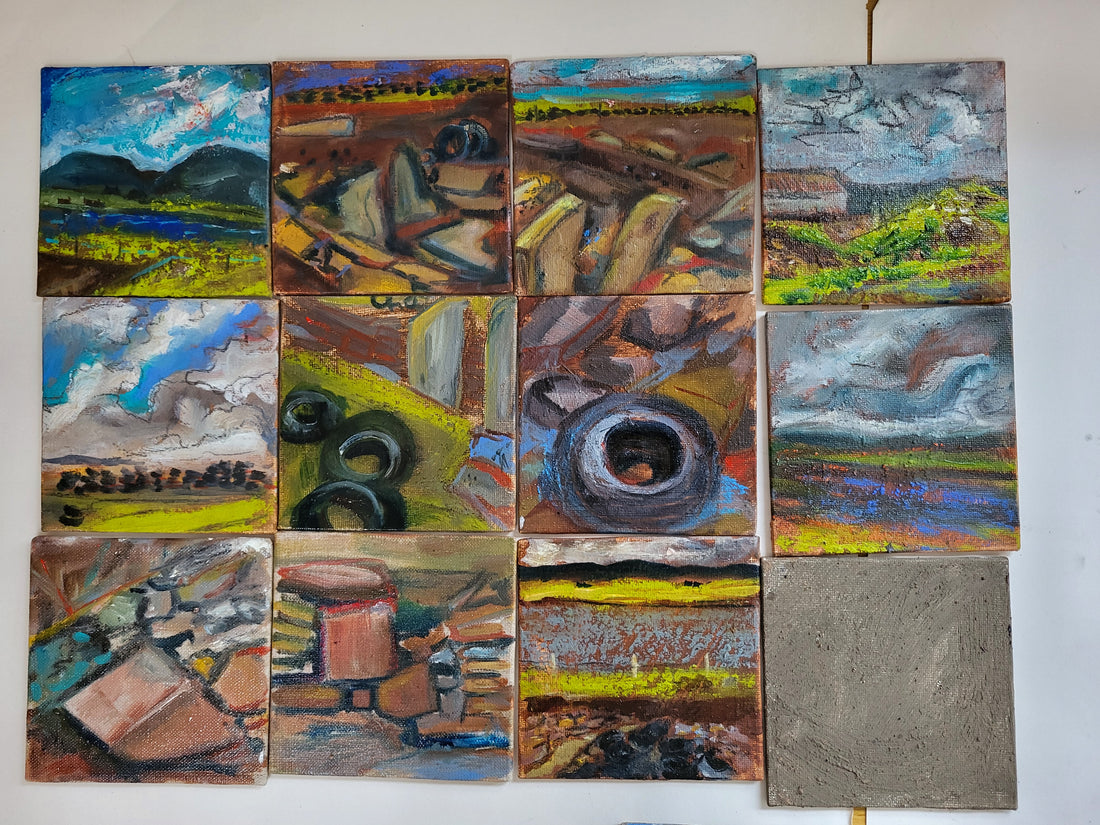This is the final season for the archaeology dig at the Ness of Brodgar. Thus, it is also my last chance for sitting still and painting on the ground at the Ness. It is also still the only Neolithic site in Britain that found evidence of coloured walls and coloured pottery. https://www.nessofbrodgar.co.uk/painted-walls/ and https://www.nessofbrodgar.co.uk/more-coloured-pottery-from-the-ness/
With the kind permission from site director, Nick Card, I have taken some of the recent shovel fulls of earth from the spoil heap at the main trench, Trench P. These recent piles of earth are actually from the lowest layers of the site and so are the oldest so far. This is pretty cool!
I let the earth dry out and then sifted it with common garden riddles.  This removed large pebbles and roots. I then decided to try some pounding with a stone mortar and pestle.
This removed large pebbles and roots. I then decided to try some pounding with a stone mortar and pestle.  Finally, I sifted it through a fine stainless steel stainer often using the pestle to still move the larger but smaller bits into a finer powder.
Finally, I sifted it through a fine stainless steel stainer often using the pestle to still move the larger but smaller bits into a finer powder.
Then I added water and a gesso binder to create a lovely Ness Mud! In many countries of the world, particularly Africa, mud alone is applied to a fabric and left to dry. It will flake off, but it will also stain the fabric, leaving it covered nicely in "earthy colours". To make colour stick best to a surface, a binder is needed. It is believed that Neolithic folks used pigments mixed with natural binders to make paint. These binders were made from vegetable juices, plant oils, urine, tree animal fat, bone marrow, blood and egg white. Research has just started to find out what was being used at the Ness as a binder. It looks like pigment was mixed with animal fat, milk, or egg white to create a sticky, paste-like paint.
I became a bit bored with the brown of the spoil heap earth, so I added in ochre and haematite powdered pigment to create more reddish or yellowish colours. Nearly every site on Orkney has unearthed a bit of the stone, haematite. Haematite can produce several different colours and bits have been found in areas at the Ness and Skarabrae where small stone or clay pots had pigment in them. The versatile Christopher Gee, experiemental archaeologist, has been involved in much producting haematite pigment and applying it to stones.
Nearly every site on Orkney has unearthed a bit of the stone, haematite. Haematite can produce several different colours and bits have been found in areas at the Ness and Skarabrae where small stone or clay pots had pigment in them. The versatile Christopher Gee, experiemental archaeologist, has been involved in much producting haematite pigment and applying it to stones.
I applied these various mixtures to the surface of my white linen canvas boards and stretched canvas and let it dry for 24 hours grounding them in the Ness.  I continue to use oil paints which are so resilient in wet and wild weather. I will also continue to incise and add charcoal into my works. So this season, many of my pieces of art will be literally and actually based on the "ground" at the Ness of Brodgar.
I continue to use oil paints which are so resilient in wet and wild weather. I will also continue to incise and add charcoal into my works. So this season, many of my pieces of art will be literally and actually based on the "ground" at the Ness of Brodgar.
*“Grounding” is the term given to the application of a “ground” color onto the canvas which will then be painted over. It's the first step in the process of painting and should (almost) never be skipped.
An brief description of artists' use of natural pigments and binders. https://www.the-fine-art-collective.com/en/2021/04/23/painting-with-mud-by-alastair-gordon/
Karen Wallis, another artist in residence at the Ness of Brodgar has done much exploring of the possible pigment stones found at the the Ness https://www.nessofbrodgar.co.uk/from-the-art-hut-contemplating-pigments/

